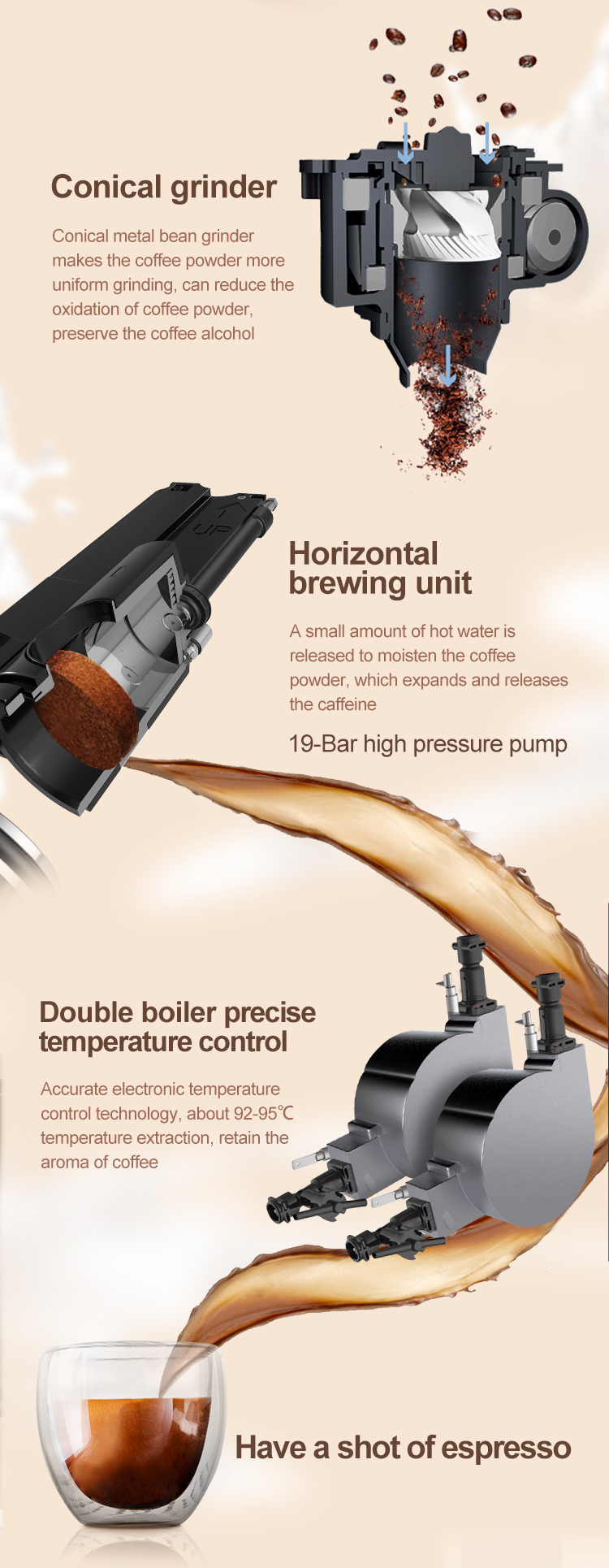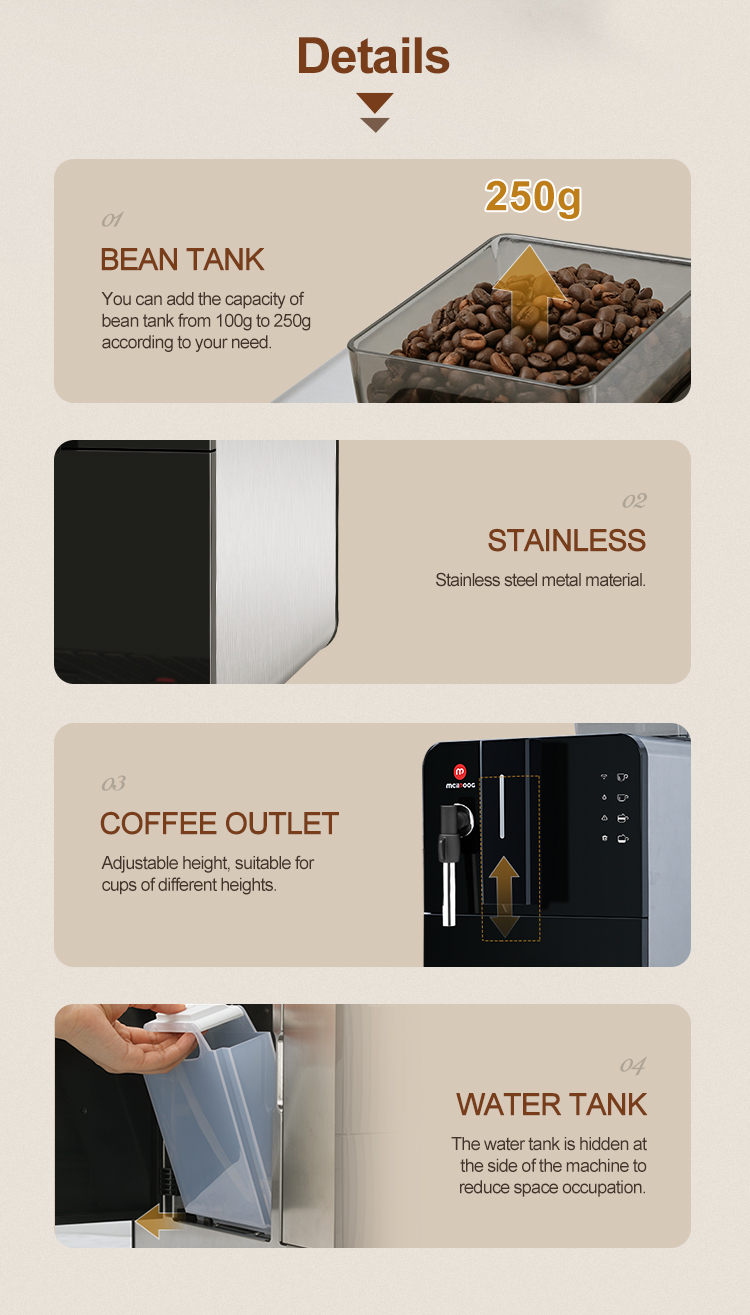How Does An Automatic Coffee Machine Work?
Apr 06, 2023
Coffee is one of the most popular and beloved beverages in the world, and for many people, it’s an essential part of their morning routine. Whether you prefer a strong espresso, a creamy latte, or a frothy cappuccino, an automatic coffee machine can help you enjoy your favorite coffee drinks with ease and convenience.

But have you ever wondered how these machines work? In this article, we’ll take a closer look at the inner workings of an automatic coffee machine and explore how they transform simple ingredients like water and coffee beans into delicious and satisfying drinks.
What is an Automatic Coffee Machine?
Before we dive into how an automatic coffee maker works, let’s start with a quick overview of what it is. An automatic coffee maker is a type of coffee maker that uses pre-ground coffee beans, coffee pods or capsules, or sometimes whole coffee beans to make various types of coffee drinks. Most of these machines have built-in grinders, milk frothers, and other features that allow users to make a wide range of coffee drinks with just a few clicks of the button.

How Does an Automatic Coffee Machine Work?
Now, let’s get into the details of how an automatic coffee machine works. The process of making coffee with these machines can vary depending on the brand and model, but most machines follow a similar set of steps.
Step 1: Grinding the Coffee Beans
The first step in making coffee with an automatic coffee maker is to grind the coffee beans. Many machines have built-in grinders that can be adjusted to produce different levels of grind, from coarse to fine. A finer grind is generally used for espresso, while a coarser grind is used for larger coffee drinks like a French press.
Step 2: Tamping the Coffee Grounds
After the coffee beans have been ground, the machine tamps or compresses the grounds into a compact puck. This step is important because it creates a consistent and even surface for the hot water to flow through, which helps to extract the flavorful oils and aroma compounds from the coffee.
Step 3: Heating Water to the Optimal Temperature
Once the coffee grounds are tamped, the machine heats water to the optimal temperature, which is around 200-205 degrees Fahrenheit for most coffee drinks. Some machines have a temperature gauge that allows users to adjust the water temperature to their liking.
Step 4: Brewing the Coffee
With the coffee grounds compacted and the water heated, it’s time for the machine to start brewing the coffee. The hot water is forced through the compacted puck of coffee grounds at a high pressure, which helps to extract the flavors and oils from the coffee. The resulting coffee is collected in a cup or carafe placed below the machine’s spout.
Step 5: Frothing Milk
Many automatic coffee machines also have a built-in milk frother, which allows users to make creamy and frothy milk-based drinks like lattes and cappuccinos. The frother heats the milk and agitates it to create a frothy texture that adds a creamy richness to the coffee drinks.
Step 6: Dispensing the Coffee Drink
Finally, it’s time to enjoy the delicious coffee drink. The machine dispenses the brewed coffee and frothed milk (if applicable) into a cup or carafe, and the user can add additional flavors or sweeteners if desired.
Automatic Coffee Machine Design
The above steps outline the basic workings of an automatic coffee machine, but these machines can vary in design and complexity. Some machines are more compact and have fewer features, while others are larger and have more customization options. Here are some additional design features found in some automatic coffee machines:
- Adjustable grind settings: Some machines allow users to adjust the grinder settings to create a coarser or finer grind.
- Milk frothing temperature control: Some machines have temperature controls for the milk frothing feature, allowing users to adjust the temperature of the milk to their liking.
- Programmable settings: Many automatic coffee machines have programmable settings that allow users to customize their coffee drinks by adjusting the water and milk volume, temperature, and brew strength.
- Cleaning and maintenance: Many automatic coffee machines have self-cleaning and descaling cycles built in to ensure the machine stays in good condition for longer.

Conclusion
Automatic coffee machines are a convenient and easy way to enjoy a delicious cup of coffee without having to leave your home. These machines work by grinding coffee beans, compacting the grounds, heating water to the optimal temperature, brewing the coffee, frothing milk (if applicable), and dispensing the drink into a cup or carafe. Different models and brands of automatic coffee machines may have additional features and settings that allow for further customization of your coffee drinks.
Whether you’re a coffee enthusiast or just want a quick and easy morning drink, an automatic coffee machine is a great investment that can bring you the perfect cup of coffee every time.

